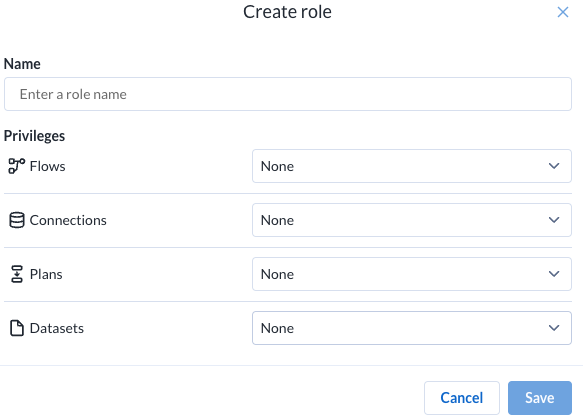Create Role
Importante
Si eres un nuevo cliente de Alteryx a partir de la primavera de 2025, es posible que estés utilizando una edición Alteryx. Los roles y capacidades de usuario han cambiado. Visita Descripción general para obtener más información.
Administrators can create and assign roles to users to govern access to user-created objects in the Alteryx One.
A role is a set of privileges that can be assigned to users.
A privilege governs access level to a type of object.
By default, all users are assigned the
defaultrole, which allows users to use the user-created object types.For more information, go to Privileges and Roles Reference.
As needed, you can create user roles to define different access levels for different object types.
Nota
You must be an administrator to create new roles.
Nota
Roles are additive. If you assign multiple roles to a user account, the user receives the highest level of access for each privilege among the assigned roles.
Nota
When a role is assigned, unassigned, or modified, the changes to privileges are immediately applied to the associated user accounts. A new login is not required.
Create Role
To create a new role, please complete the following steps.
In the left navigation bar, select User menu > Admin console > Roles.
In the Roles page, review the list of available roles. For more information, go to Roles Page.
To create a new role, select Create Role.

In the Create Role dialog, specify the following:
Name: Enter a name for your role. This value must be unique among available roles.
Privileges
For each of the available object types, specify the access level for the role.
For more information on these privileges, go to Privileges and Roles Reference.
To create the role, select Save.
The role is now available and can be assigned to users. See below.
For more information, go to Create Role Dialog.
Example - Read-only access role
Suppose you wish to limit a set of users to read-only access to role-based objects.
In the Roles page, select Create role.
In the Create Role dialog, enter the following:
Name:
read-onlyPrivileges: For each available privilege, select
viewer.Nota
Some privileges may not have a
vieweraccess level. For these privileges, you should selectnone. However, users with such a role cannot access the pages where these objects are listed.
Select Save.
The role is now available and can be assigned to users. See below.
Example - Empty role
In some circumstances, you may wish to assign an empty role to a user. For example, you may wish to limit some administrators to only be able to configure aspects of the platform without providing access to any user-created objects.
In the Roles page, select Create role.
In the Create Role dialog, enter the following:
Name:
emptyPrivileges:
For every privilege, select
none.
Select Save.
The role is now available and can be assigned to users. See below.
Assign Role
After a role has been created, you can assign it to users.
Nota
Assigning a role adds the role to the user's account. It does not replace any role that is already present in the account.
Nota
When you assign or unassign a role, the privileges are immediately applied to the assigned user's account. The user does not need to re-login to see the changes.
In the Roles page, locate the role to assign.
On the right side of the screen, click the context menu for the role. Select Assign role....
In the Assign role dialog, enter a list of email addresses for users to whom you wish to assign the role.
Select Assign.
The role and its associated privileges are applied immediately to the user accounts.
Modify Role
After a role has been created, you can modify it as needed.
Nota
When the privileges of a role are modified, the changes are applied immediately to all users who are currently assigned the role. Before making modifications, you should review the users who could be affected. Go to Role Details Page.
In the Roles page, locate the role to modify.
In the context menu on the right side of the page, select Edit.
Review the privileges assigned to the role, and make any changes as necessary.
Select Save.
All users who currently have the role in their account immediately receive the changed privileges.
Unassign Role
Use the following steps to remove a role from a user account.
Nota
Removing a role from a user account may remove access to objects that the user has created. If the user is the owner of these objects, some access may be removed permanently, even if the object is shared.
In the Roles page, locate the role that you wish to remove from one or more user accounts.
Select the role.
In the Role Details page, select the Users tab.
Locate the user to un-assign the role. In the context menu for the user, select Unassign from role.
The user no longer has the role in the account.
For more information, go to Role Details Page.
Delete Role
Aviso
You are permitted to delete roles that are still assigned to users. Deleting a role removes the role from all user accounts and cannot be undone. Before you delete a role, you should review the list of affected users and the objects to which they have access.
In the Roles page, locate the role to delete. In the context menu, select Delete.
Confirm the deletion.
The role is deleted. All users who had the role can no longer access the privileges assigned in the role.
For more information, go to Roles Page.